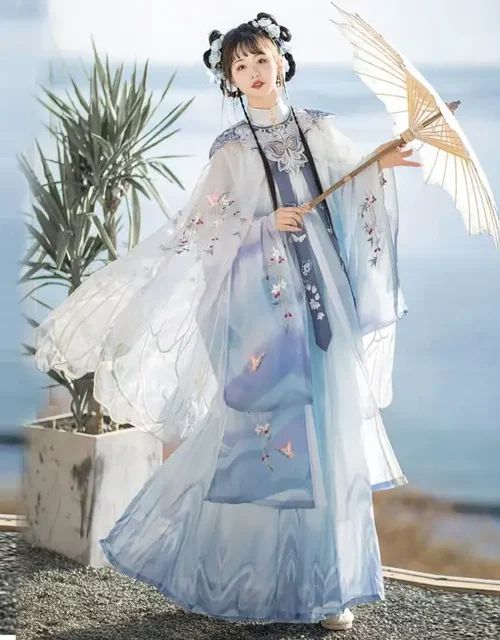The Origins and Early Development of the Bat Pattern on Hanfu
Cultural Roots of the Bat Pattern
The bat pattern is a common motif in Chinese culture and has adorned Hanfu, the traditional Chinese attire, for centuries. Its origins can be traced back to ancient times when bats were revered as symbols of good fortune and longevity.

The Rise of the Bat Pattern During the Han Dynasty
During the Han dynasty (206 BCE – 220 CE), the bat pattern emerged as a popular decorative element on Hanfu. The Chinese character for “bat” (蝠) is a homophone for “blessing” (福), further enhancing the auspicious connotations of the bat design. Bats were often depicted in pairs, symbolizing double happiness or blessings.
Elaboration of the Bat Pattern in the Tang and Song Dynasties
As Hanfu evolved through the Tang (618-907 CE) and Song (960-1279 CE) dynasties, the bat pattern became more intricate. Artisans used various techniques like embroidery, printing, and weaving to create elaborate and vibrant designs. The bat motif was often combined with other auspicious symbols such as clouds, flowers, and animals to convey wishes for prosperity, longevity, and harmony.
The Development of the Bat Pattern in the Ming and Qing Dynasties
The Peak of the Bat Pattern in the Ming Dynasty
During the Ming (1368-1644 CE) and Qing (1644-1912 CE) dynasties, the bat pattern reached its peak of popularity. It was widely used in both formal and informal Hanfu, from the elaborate robes of emperors and officials to the everyday garments of commoners. The bat motif became a symbol of status and refinement, and its presence on Hanfu was considered a mark of good taste and auspiciousness.

Revival of the Bat Pattern in Modern Times
In the 20th century, the bat pattern experienced a resurgence in popularity as part of a broader revival of interest in traditional Chinese culture. Contemporary designers have reinterpreted the motif in innovative ways, incorporating it into a variety of fashion items, from clothing to accessories.
The Role of the Bat Pattern in Modern Hanfu
Today, the bat pattern remains an integral part of Hanfu, symbolizing the rich cultural heritage and auspicious beliefs of the Chinese people. Its lasting popularity demonstrates the enduring power of tradition and the timeless appeal of auspicious symbols.
The Symbolism and Cultural Significance of the Bat Pattern in Hanfu
The Cultural Symbolism of the Bat Pattern in Hanfu
The bat pattern, a prominent motif in Chinese culture, holds profound significance within Hanfu, the traditional attire of the Han Chinese. Its evolution over centuries mirrors the cultural and aesthetic transformations that have shaped the rich tapestry of Hanfu.

In ancient China, bats were seen as symbols of good fortune and longevity. Their nocturnal habits and ability to navigate the dark were interpreted as metaphors for overcoming adversity and achieving prosperity. Consequently, the bat pattern became a popular decorative feature on Hanfu, particularly during the Han dynasty (206 BCE – 220 CE).
Transformation of the Bat Pattern in the Tang Dynasty
During the Tang dynasty (618-907 CE), the bat pattern underwent significant changes, becoming more stylized and elaborate. It often incorporated auspicious symbols like clouds, mountains, and flowers. The use of vibrant colors and gold thread further heightened its grandeur. This shift mirrored the Tang dynasty’s flourishing economy and cultural sophistication.
Evolution of the Bat Pattern in the Song, Ming, and Qing Dynasties
Naturalistic Depiction in the Song Dynasty
In the Song dynasty (960-1279 CE), the bat pattern continued to evolve, becoming more naturalistic and detailed. Artists depicted bats in various poses—flying, roosting, or playing. Ink wash painting techniques added depth and movement to these designs. This period also saw the emergence of the “five bat” pattern, symbolizing the five blessings of longevity, wealth, health, virtue, and a peaceful death.

The Zenith of the Bat Pattern in the Ming Dynasty
The Ming dynasty (1368-1644 CE) marked the height of the bat pattern’s popularity. It was widely incorporated into many Hanfu garments, from formal robes to everyday wear. Designs became more intricate, featuring multiple layers of bats and other auspicious symbols. The use of bright colors and gold embroidery emphasized the celebratory and festive nature of the pattern.

Changes in the Qing Dynasty and Modern Legacy
Continuation and Decline in the Qing Dynasty
In the Qing dynasty (1644-1912 CE), the bat pattern continued to be used in Hanfu, though its popularity gradually declined. The influence of Western fashion and Manchu culture led to changes in aesthetic preferences. However, the bat pattern remained a vital symbol of good fortune, often appearing in ceremonial garments and auspicious textiles.
The Bat Pattern in Contemporary Hanfu
Innovative Uses of the Bat Pattern Today
Today, the bat pattern remains an essential element in Hanfu culture. It is used not only on traditional garments but also in modern interpretations of Hanfu and accessories. The continued popularity of the bat pattern highlights the lasting influence of this auspicious symbol in Chinese culture. With contemporary designers reimagining the motif, the bat pattern continues to evolve, blending tradition with modernity.
Cultural Legacy of the Bat Pattern
The evolution of the bat pattern reflects the dynamic nature of Chinese art and the cultural transformations that have shaped Han Chinese identity over centuries. From ancient times to the present day, the bat motif has remained a symbol of prosperity, happiness, and longevity. Its enduring presence showcases the depth of Chinese cultural heritage and its vibrant artistic tradition.
